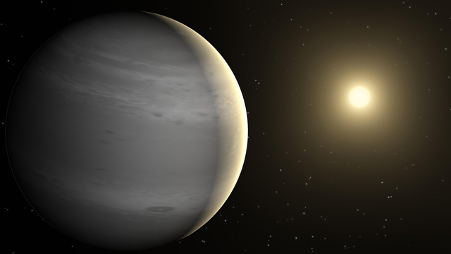Cycle 3 JWST observation time awarded to study some of the coolest gas giant planets beyond our solar system
The Exoplanets and Habitability Group will be involved in four projects that have been awarded with observation time in the third cycle of proposal calls using the Mid InfraRed Instrument (MIRI) onboard the James Webb Space Telescope (JWST), three of them as Principal Investigator. The projects will result in an improved understanding of the characteristics and formation of cold companions.
Observation time with JWST is granted according to accepted proposals in yearly proposal cycles. During the third cycle of proposal calls researchers from all over the world and across all fields in astrophysics were invited to hand in their project ideas to receive the requested time of observation. The process is highly competitive, as during this cycle about 48’000 hours of observation time were requested and only 5’500 hours got accepted - in other words, only every 9th proposal got accepted. This has been the most oversubscribed cycle thus far and it is expected that observation time will get more and more competitive from year to year. The observations selected in this cycle will be observed from mid 2024 to mid 2025.
Our group is leading or involved in four distinct projects:
1. Testing a new formation tracer for cold gas giants with JWST/MIRI [3.5 hours].
A recently detected formation tracer of the isotopologues 15NH3/14NH3 helps to understand the formation history of cold brown dwarfs and gas giants. Their atmospheres are mostly defined by nitrogen chemistry which can be observed in the mid infrared. Thus, MIRI is the ideal instrument to characterize cold companions such as the closest and coldest up to date imaged companion COCONUTS-2b. For different formation scenarios the formation tracer ratio value will differ, so by measuring the tracer, we will get a better understanding of the gas giant’s early evolution.
2. Two for the price of one: complete spectroscopy from 0.7 to 23 micron of the benchmark brown dwarfs Eps Ind BA and BB [4 hours].
The system of Eps Ind BA/BB will be observed with MIRI to better understand the evolution of this object by measuring formation tracers and characterizing its bulk properties. This system is highly dynamic consisting of a binary brown dwarf orbiting a main sequence star together with a wide angle super Jupiter companion. Special about this system is that their orbits and with that their masses are well constrained. This vastly improves the characterization of the atmospheres and thus conclusions about the formation history.
3. A spectroscopic exploration of a directly imaged multiplanet system in the mid infrared [19 hours].
The planetary system HR 8799 hosts four gas giants and has been one of the cornerstones of directly imaged exoplanets. With this proposal we will obtain spectra of the outer three planets in the mid-infrared for the first time, with the goal of exploring their cloud properties and chemistry.
4. Resolving the Radio Riddle: Unveiling the Radio emission in a Red Dwarf and its wide orbit companion [5 hours].
Radio emission from a nearby M dwarf puzzled researchers, leading to the discovery of a potential long period gas giant in the system using radial velocity measurements which could explain the radio signal. We will try to image this object using the NIRCam instrument on JWST, to confirm the existence of the planets, constrain its mass and set the first limits on the magnetic field of a planet outside the solar system.
Sources:
- Barrado, D., Mollière, P., Patapis, P. et al. external page15NH3 in the atmosphere of a cool brown dwarf. Nature 624, 263–266 (2023).
- external pageJWST is most in-demand telescope ever — leaving many astronomers in the cold, Nature 626, 464-465 (2024)

